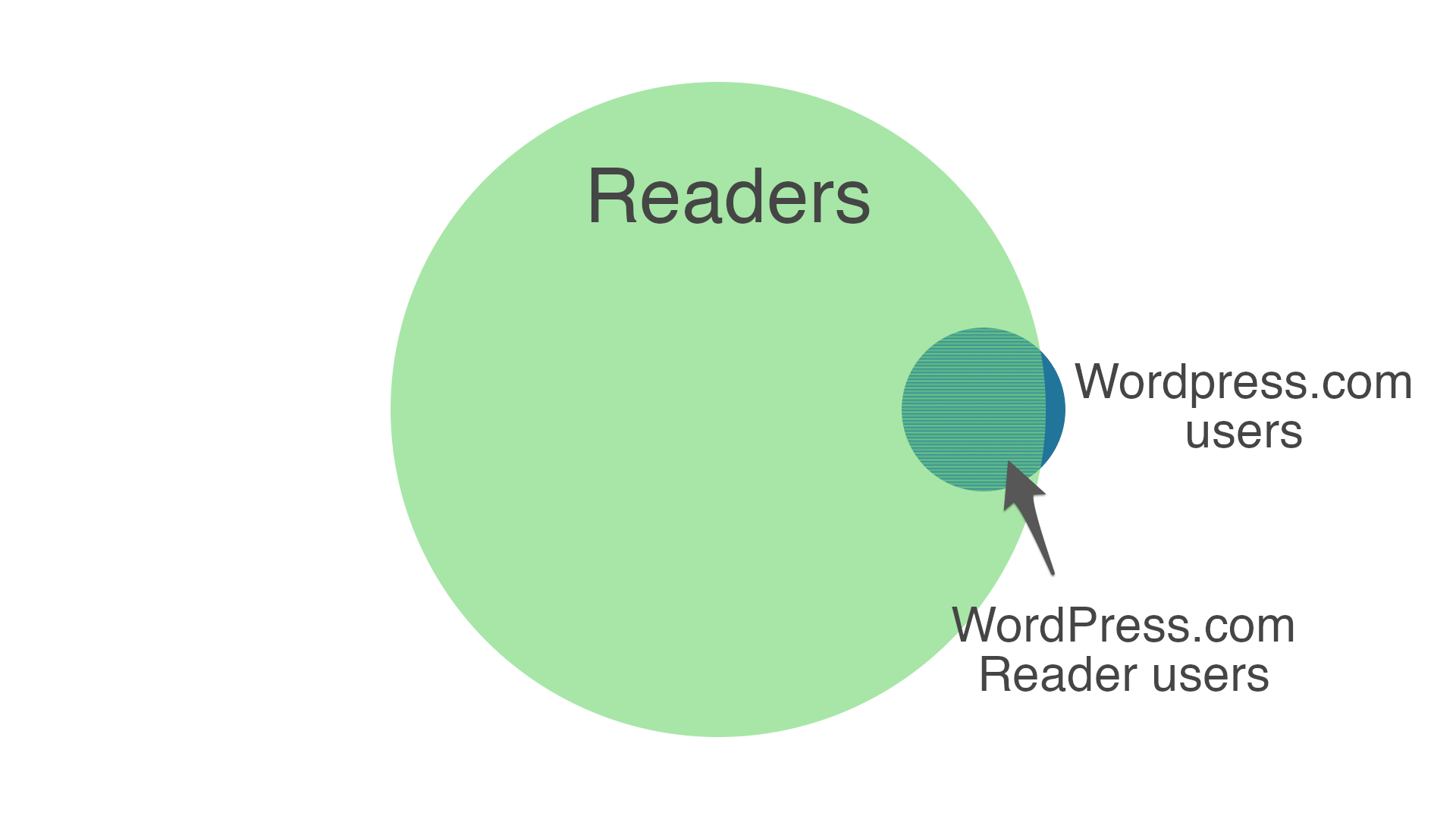Why?
- Because I miss Google Reader.
- Because WordPress.com Reader is a good early product in an under-served market, but wasting its potential due to muddled positioning.
- Because a successful Reader will provide a valuable service to both consumers and publishers, and provide WordPress.com a marketing and data edge.
What muddled positioning?
WordPress.com is a destination for writers, publishers and creators. Reader is a tool for readers and consumers.
The Reader is bundled into WordPress.com behind a sign-up screen that talks only about creating, not reading. A majority of content consumers don’t create, at least not at WordPress.com. So they never sign-up, and the Reader remains inaccessible, even unknown, to a vast majority of consumers of content.1
All the un-patterned green space represents the readers who don’t have access to WordPress.com Reader
So, what do you suggest?
Make Reader a great, independent destination for reading, following and interacting with people, topics, and publishers. With a slight WordPress.com bias.
A destination for reading, following, and consumption
- Its own web domain, and independent smartphone apps.
- A great-in-class reading experience, perhaps augmented with acquisitions (Instapaper?) and integrations (Save to Pocket, share highlights to social media, send to Kindle)
- A great-in-class social experience—follows, recommendations, reading and writing comments (directly from within the Reader), and likes.
- Wide compatibility—not just RSS feeds. If a CMS has an API, and there’s marginally meaningful usage, integrate it. (The Dropbox strategy)
- Integrated premium subscriptions2—from Longreads and Stratechery, to NYT and The Economist.
- Integrated newsletter subscriptions3 and reading.
Empower publishers—more readers, more analytics, integrated premium subscriptions, trends, adverts, tag and content suggestions (based on content consumption data)
Promote WordPress.com
- Deeper integration with WordPress.com/Jetpack sites for data analytics, suggestions, and discover.
- ‘Sign-up to Reader’ to sync feeds across devices, and to comment and like posts. Use the same account to create on WordPress.com.
- Integration for WordPress.com/Jetpack content, and prompts to encourage readers to create—‘write’ or ‘respond’.
- Integrated simple ‘writer’ mode for writing, re-posting, commenting, linking from own sites.
Use it as an ambush marketing tool—provide great-in-class integration for competing CMS (Medium, Ghost, Squarespace, others)
- A uniform, great-in-class reading experience in native apps (registered as receivers of URL intents on devices)
- Use API access, where available, to provide interactivity with their content (claps, comment, likes)
- Reduce ‘visits’ to competitor websites by consuming them in-app—remove their uniqueness via aggregation
One more thing…
Outsource innovation: Provide a ‘Reader API’ to allow others to build upon the Reader with additional features. Build/buy the best innovations.
Where do we start?
I’m a fan of starting minimally and quietly.
Clone the Reader to an independent domain with independent landing and login pages. This provides a quick, non-disruptive way of creating an independent destination.
Next step would be publishing independent smartphone apps. I’d also attach a ‘beta’ sign to indicate to the fragility of the experiment.
Then we go on a fast release cycle of feature iterations, focused initially on ‘reading’ and ‘social’.
All opinion notes:
- We need to do something about the WordPress.com Reader
- Jetpack: the Automattic experience for WordPress
- WooHoo.com—a hosted, tightly-integrated version of WooCommerce
- Woo Two — More ideas for WooCommerce
- Earn with WordPress
- Pricing—more and less
- TBC: A publishing platform for today’s content formats
- I wrote about this 2+ years ago: A case for splitting up the WordPress mobile app. It’s still relevant. ↩
- Automattic must also provide a premium subscriptions solution—to be shared in an upcoming update. ↩
- WordPress.com must also provide an integrated newsletters feature set—to be shared in an upcoming update. ↩
